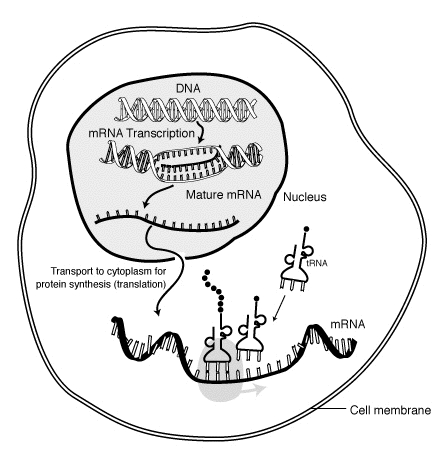Decoding Genetic Information
In principle, decoding genetic information is simple. At the start of the gene, the enzyme DNA polymerase unwinds the DNA double spiral for a segment of about 15 nucleotides, and the information from one of the strands is copied to messenger RNA (mRNA) [1]. The mRNA contains all of the information from the copied DNA segment but translated from the DNA alphabet of ACGT into the RNA alphabet of ACGU, so T is substituted by U (see Figs. 1 and 2).
 |
|
Figure 1. DNA (CTAG) and RNA bases (CUAG). |
 |
|
Figure 2. Transcription (synthesis of RNA based on the DNA template) and translation (base sequence in the mRNA is translated into the amino acid sequence of the protein). (Source: National Institutes of Health, USA) |
 Decoding the information contained in the mRNA and linking the resulting amino acids in the correct order takes place in the ribosome (see Infobox 2). Every second, the ribosome links together 10–20 amino acids, with multiple ribosomes simultaneously binding to a single mRNA (parallel synthesis). Every cell contains tens of thousands of ribosomes. This overall process achieves high synthetic efficiency.
Decoding the information contained in the mRNA and linking the resulting amino acids in the correct order takes place in the ribosome (see Infobox 2). Every second, the ribosome links together 10–20 amino acids, with multiple ribosomes simultaneously binding to a single mRNA (parallel synthesis). Every cell contains tens of thousands of ribosomes. This overall process achieves high synthetic efficiency.
References
[1] R. D. Kornberg, The molecular basis of eukaryotic transcription, Proc. Natl. Acad. Sci. USA 2007, 104, 12955. https://doi.org/10.1073/pnas.0704138104



